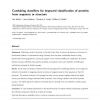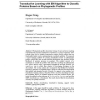409 search results - page 25 / 82 » Predicting Nucleolar Proteins Using Support-Vector Machines |
BMCBI
2008
13 years 8 months ago
2008
Background: Predicting a protein's structural or functional class from its amino acid sequence or structure is a fundamental problem in computational biology. Recently, there...
BMCBI
2006
13 years 8 months ago
2006
Background: The majority of peptide bonds in proteins are found to occur in the trans conformation. However, for proline residues, a considerable fraction of Prolyl peptide bonds ...
BMCBI
2008
13 years 8 months ago
2008
Background: Mass spectrometry is a key technique in proteomics and can be used to analyze complex samples quickly. One key problem with the mass spectrometric analysis of peptides...
IJON
2010
13 years 5 months ago
2010
Several solutions have been proposed to exploit the availability of heterogeneous sources of biomolecular data for gene function prediction, but few attention has been dedicated t...
IJDMB
2007
13 years 8 months ago
2007
: Phylogenetic profiles of proteins strings of ones and zeros encoding respectively the presence and absence of proteins in a group of genomes have recently been used to id...


